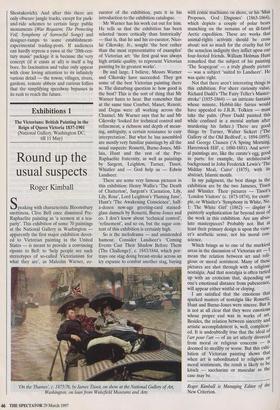Music
The overlong
20th century
Robin Holloway
Athe 20th century nears its end the futility of trying to present its music as a coherent entity becomes plain. The 100- year unit is far too large to measure change, be it slow organic growth, the swing of the pendulum, or the occasional revolutionary shock. True dimensions for music's epochs are smaller and far more Interesting. Some facts and figures from the past give something more approaching the salient contours of time.
For instance, the deaths of the Baroque's crowning masters — Bach in 1750, Scarlatti 1757, Handel 1759, Rameau 1764 — over- lap with the early output of Haydn (born 1732) who in 1781 published his six quar- tets op. 33 'written in a quite new and spe- cial manner' from which the youthful maturity of the classical style is commonly dated. Its virile prime could be typified by Beethoven's three Razumovsky quartets of 1806; its profound old age by his last quar- tets, which synchronise exactly with the last three by the young Schubert in the mid- 1820s. Or take some milestones in the art of Lieder, it seems but the twinkling of an eye between Schubert's cycles (Die schone Midlerin 1823, Winterreise 1827-28) and Schumann's celebrated efflorescence of song in 1840. Across this twinkling comes half of Chopin's piano output (c. 1830-49), all Bellini (died 1835), the greater part of Donizetti (active till 1843), the best of Berlioz, and the romantic operas of the young Wagner, up to the completion of Lohengrin in 1848. When the new world of music-drama gradually unfolds in the 1850s it is still only 30 years on from the last works of Beethoven and Schubert. The music-drama epoch, closing in 1882 with Parstfal, also sees the rise of several Slavon- ic national styles, the maturity of Brahms and Bruckner, the long prime of Verdi, and the delicious Frenchness of Delibes and Bizet.
All this (I could go on multiplying exam- ples for ever) simply reinforces the obvi- ous, that music's chapters are relatively brief, and irreducibly surprising, successive and simultaneous.
So how does the so-called 20th century appear to the aerial photographer; or how would the cunning butcher best divide the carcass? Great wars make natural divisions. The evolution of ripe romanticism into bursting modernism, from the 1890s to 1914, forms a viable unit whose richness and intensity continues to haunt, even dominate, all subsequent compositional endeavour. Then at the threshold of the 1920s music's tempo and temperature changes so drastically that it has to be seen as a major swing of the pendulum. Between the wars even Richard Strauss tightened his belt (a little).
But a list of major losses from the early 1940s to 1950s will show how pluralistic the scene remained: Rachmaninov died in 1943, Bart& and Webern 1945, Falla 1946, Strauss and Pfitzner 1949, Weill and Koechlin 1950, Schoenberg 1951, Prokofiev 1953, Ives 1954 — sunset romantics, nation- alists, moderns, neo-classics, constructivists, mavericks, loosely jostled together by the mere coincidence of their deaths. As the Fifties progressed, an avant-garde born out of the technique of the deceased Webern spread from Paris to form the aggressive left wing of a reconstructed Europe, while simultaneously the epoch's greatest diatoni- cists, ranging from Stravinsky (68 in 1950) to Britten (37) by way of Copland (50) and Shostakovich (45), essayed techniques born of the deceased Schoenberg with results ranging from an extra string for the bow, to a radical rebirth and recharging.
And the Fifties are now 40 years ago! There has surely been motion since then: if not another unmistakable swing of the pen- dulum, then multifarious eddies and surges which have yet again transformed the face of an art that never stays still. The worst result of freezing '20th-century music' into one solid block is that its enormous diversi- ty and constant change are narrowed into a canon. No one would dream of conceiving '19th-century' or '18th-century' music the same way. And as this canon hardens into concrete, it is enforced like the Tables of the Law: a cordon sanitaire around an ever- diminishing herd of sacred cows. All the currently on-going journeys through the last ten decades of music tend to take a six- lane speedway until some vague semi-colon is reached (not possible to locate exactly, but somehow 1940s-ish, with Strauss's Four Last Songs, Bartok's Concerto for Orchestra, Copland's Appalachian Spring, Messiaen's Turangalila, Britten's Peter Grimes, middle Shostakovich). And after this there are only obscure jungle tracks, except for park- and-ride schemes to certain large public monuments (War Requiem, The Protecting Veil, Symphony of Sorrowful Songs) and designer-ramps to some establishment- experimental trading-posts. If audiences can hardly repress a yawn at the '20th-cen- tury music' package it is because the very concept (if it exists at all) is itself a big bore. Its fascination and value only appear with close loving attention to its infinitely various detail — the towns, villages, rivers, gardens, remote abbeys and curious follies that the simplifying speedway bypasses in its rush to reach the future.



































































 Previous page
Previous page